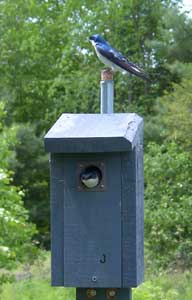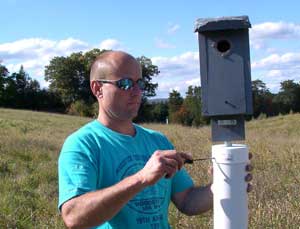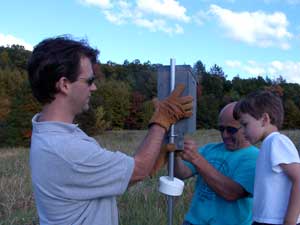Woodstock Landfill is for the Birds
Status: 97 birds fledged so far: in 2005, 8 Eastern Bluebirds, and 31 Tree Swallows fledged from 13 boxes. In 2006, 17 Eastern Bluebirds, 38 Tree Swallows and 3 House Wrens were fledged from 15 boxes. In 2007, 13 bluebirds, 33 Tree Swallows and 4 Black-capped Chickadees fledged from 18 boxes.
Sad Note: Many of these boxes were removed without notice by the Town when they put up solar panels, and they did not notify me.


Thirteen new houses have gone up on the Woodstock Landfill in Connecticut! Birdhouses that is. Even though it’s a “dump,” it’s still great habitat for bluebirds. The closed landfill, located behind the Transfer Station, was used for solid waste disposal from the mid 1940’s-1993. It is now covered with short grass.
Bluebirds prefer to hunt and nest in open, grassy areas. After consulting with the CT Dept. of Environmental Protection* to make sure that the boxes would not interfere in any way with controls put in place when the landfill was closed, a bluebird trail was set up.
When most people hear the word “trail,” they think of a walking trail, but a “bluebird trail” is actually a series of nestboxes.** For safety reasons, the closed area beyond the brush pile is not open to the general public. However, hopefully visitors to the Transfer Station will get to see more birds because of the new nestboxes.
The boxes are inviting to birds that need to nest in cavities, such as bluebirds, Tree Swallows, chickadees, and tufted titmice. Last year, two test nestboxes were set up along the road that goes up the hill to the closed landfill area. Tree Swallows immediately nested in the boxes. An additional ten boxes were installed on October 10, 2004. Six were donated by the Eastern CT Forest Landowners Association/Wolf Den Land Trust (ECFLA/WDLT). The trail is dedicated to late Robert V. Smith, an ECFLA/WDLT volunteer who built thousands of bluebird boxes sold at fairs and events. Jeff Perkins, past ECFLA President, said “Bob Smith was a friend of the forest, steward of the land, and caretaker of the environment. The bird houses he made can now be found all over New England.” Dennis Hodgin, current ECFLA President, said “People like Bob Smith are a shining example of the power we all have to make a difference.”
 The remaining boxes and materials were also provided at no cost to the town. Bet, who manages a bluebird trail in Northeastern CT that fledged 104 native birds in 2004, including 26 bluebirds, will handle the monitoring. All nestboxes should be monitored to remove any House Sparrow nests or eggs (a non-native bird that attacks bluebirds and their eggs and nestlings), and address any problems that crop up. The selectmen, and Bob Blair who supervises activities at the Transfer Station, approved installation of the bluebird trail, and were very supportive of the project.
The remaining boxes and materials were also provided at no cost to the town. Bet, who manages a bluebird trail in Northeastern CT that fledged 104 native birds in 2004, including 26 bluebirds, will handle the monitoring. All nestboxes should be monitored to remove any House Sparrow nests or eggs (a non-native bird that attacks bluebirds and their eggs and nestlings), and address any problems that crop up. The selectmen, and Bob Blair who supervises activities at the Transfer Station, approved installation of the bluebird trail, and were very supportive of the project.
Bluebird populations declined by an estimated 90% from 1920-1970, threatened by competition from introduced species (House Sparrows and starlings), loss of open space and natural nesting cavities, increased pesticide use, and harsh winters. Eastern Bluebird populations are now increasing due to grass roots conservation efforts, but none of the issues that caused the decline has really gone away. Ongoing help from individuals and groups is critical to bluebird survival.
Information about ECFLA/WDLT and the Robert V. Smith Memorial Fund is available at www.ecfla.org. Those interested in bluebird conservation can check out www.sialis.org or contact E.A. Zimmerman.
* The closed landfill is covered by a clay cap, so there was no need to worry about puncturing a membrane when installing the boxes. The metal conduit that the boxes are mounted on is closed at the top (with a cork or tape) to prevent any rainwater infiltration. Boxes were placed at least 50 feet away from gas vents (mainly to prevent bird exposure to the limited amounts of methane), and 5-10 feet away from any groundwater monitoring wells.
** All boxes are mounted on metal conduit. They are equipped with capped, 4″ diameter PVC predator baffles, placed on top of a hose clamp for wobble. Boxes have been stained with Superdeck (linseed and tung oil) to preserve the wood. There are 4 NABS style boxes, 4 Peterson boxes (manufactured by Ahlgren Construction) and 4 Gilwood boxes (made by Steve Gilbertson.) One box is located at the entrance to the transfer station, one is near a dirt slope behind the “take it leave it” shack, one is along the road going up to the brush pile, one is next to the brush pile and a detention pond, and the remaining boxes are placed approximately 100 yards apart on the grassy landfill cover. The landfill is surrounded by woods. Most boxes were placed 50-200 feet away from woods/brush to prevent House Wren usage. There are no homes or farms in the immediate vicinity, which may reduce House Sparrow problems.
A man’s interest in a single bluebird is worth more
than a complete but dry list of the fauna and flora of a town.
– Henry David Thoreau, 1906
